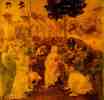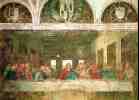Leonardo DA VINCI (b. 1452, Vinci, Republic of Florence [now in Italy]--d. May 2, 1519, Cloux, Fr.), Italian painter, draftsman, sculptor, architect, and engineer whose genius, perhaps more than that of any other figure, epitomized the Renaissance humanist ideal. His Last Supper (1495-97) and Mona Lisa (1503-06) are among the most widely popular and influential paintings of the Renaissance. His notebooks reveal a spirit of scientific inquiry and a mechanical inventiveness that were centuries ahead of his time.
 The Adoration of the Magi
The Adoration of the Magi
1481-82 (200 Kb); Yellow ochre and brown ink on panel, 246 x 243 cm (8 x 8 ft); Uffizi, Florence
 Lady with an Ermine
Lady with an Ermine
1483-90 (150 Kb); Oil on wood, 53.4 x 39.3 cm (21 x 15 1/2 in); Czartoryski Museum, Cracow
 Madonna Litta
Madonna Litta
c. 1490-91 (150 Kb); Tempera on canvas, transferred from panel, 42 x 33 cm (16 1/2 x 13 in); Hermitage, St. Petersburg
By a happy chance, a common theme links the lives of four of the famous masters of the High Renaissance -- Leonardo, Michelangelo, Raphael and Titian. Each began his artistic career with an apprenticeship to a painter who was already of good standing, and each took the same path of first accepting, then transcending, the influence of his first master. The first of these, Leonardo da Vinci (1452-1519), was the elder of the two Florentine masters. He was taught by Andrea del Verrocchio (1435-88), an engaging painter whose great achievement was his sculpture. Verrochio also had considerable influence on the early work of Michelangelo. Verrocchio's best-known painting is the famous Baptism of Christ, famous because the youthful Leonardo is said to have painted the dreamy and romantic angel on the far left, who compares more than favorably with the stubby lack of distinction in the master's owm angel immediately beside him.
Leonardo: Renaissance polymath
 The Last Supper
The Last Supper
1498 (180 Kb); Fresco, 460 x 880 cm (15 x 29 ft); Convent of Santa Maria delle Grazie (Refectory), Milan
There has never been an artist who was more fittingly, and without qualification, described as a genius. Like Shakespeare, Leonardo came from an insignificant background and rose to universal acclaim. Leonardo was the illegitimate son of a local lawyer in the small town of Vinci in the Tuscan region. His father acknowledged him and paid for his training, but we may wonder whether the strangely self-sufficient tone of Leonardo's mind was not perhaps affected by his early ambiguity of status. The definitive polymath, he had almost too many gifts, including superlative male beauty, a splendid singing voice, magnificent physique, mathematical excellence, scientific daring... the list is endless. This overabundance of talents caused him to treat his artistry lightly, seldom finishing a picture, and sometimes making rash technical experiments. The Last Supper, in the church of Santa Maria delle Grazie in Milan, for example, has almost vanished, so inadequate were his innovations in fresco preparation.
 A copy made by an apprentice of a da Vinci painting which never dried
A copy made by an apprentice of a da Vinci painting which never dried
Da vinci made numerous experiments using different colours and when painting this particular church he failed.
Yet the works what we have salvaged remain the most dazzingly poetic pictures ever created. The Mona Lisa has the innocent disavantage of being too famous. It can only be seen behind thick glass in a heaving crowd of awe-stuck sightseers. It has been reproduced in every conceivable medium: it remains intact in its magic, for ever defying the human insistence on comprehending. It is a work that we can only gaze at in silence.
 Portrait de Mona Lisa
Portrait de Mona Lisa
Leonardo's three great portraits of women all have a secret wistfulness. This quality is at its most appealing in Cecilia Gallarani, at its most enigmatic in the Mona Lisa, and at is most confrontational in Ginevra de' Benci. It is hard to gaze at the Mona Lisa, because we have so many expectations of it. Perhaps we can look more truly at a less famous portrait, Ginevra de' Benci. It has that haunting, almost unearthly beauty peculiar to Leonardo.
A withheld identity
 Ginevra de' Benci
Ginevra de' Benci
c. 1474 (150 Kb); Oil on wood, 38.2 x 36.7 cm (15 1/8 x 14 1/2 in); National Gallery of Art, Washington, DC
The subject of Ginevra de' Benci has nothing of the Mona Lisa's inward amusement, and also nothing of Cecilia's gentle submissiveness. The young woman looks past us with a wonderful luminous sulkiness. Her mouth is set in an unforgiving line of sensitive disgruntlement, her proud and perfect head is taut above the unyielding column of her neck, and her eyes seem to narrow as she endures the painter and his art. Her ringlets, infinitely subtle, cascade down from the breadth of her gleaming forehead (the forehead, incidentally, of one of the most gifted intellectuals of her time). These delicate ripples are repeated in the spikes of the juniper bush.
The desolate waters, the mists, the dark treess, the reflected gleams of still waves, all these surround and illuminate the sitter. She is totally fleshly and totally impermeable to the artist. He observes, rapt by her perfection of form, and shows us the thin veil of her upper bodice and the delicate flushing of her throat. What she is truly like she conceals; what Leonardo reveals to us is precisely this concealment, a self-absorption that spares no outward glance.
Interior depth
 The Virgin of the Rocks
The Virgin of the Rocks
1503-06 (140 Kb); Oil on wood, 189.5 x 120 cm (6 x 4 ft); National Gallery, London
We can always tell a Leonardo work by his treatment of hair, angelic in its fineness, and by the lack of any rigidity of contour. One form glides imperceptibly into another (the Italian term is sfumato), a wonder of glazes creating the most subtle of transitions between tones and shapes. The angel's face in the painting known as the Virgin of the Rocks in the National Gallery, London, or the Virgin's face in the Paris version of the same picture, have an interior wisdom, an artistic wisdom that has no pictorial rival.
This unrivalled quality meant that few artists actually show Leonardo's influence: it is as if he seemed to be in a world apart from them. Indeed he did move apart, accepting the French King François I's summons to live in France. Those who did imitate him, like Bernardini Luini of Milan (c.1485-1532) caught only the outer manner, the half-smile, the mistiness.
The shadow of a great genius is a peculiar thing. Under Rembrandt's shadow, painters flourished to the extent that we can no longer distinguish their work from his own. But Leonardo's was a chilling shadow, too deep, too dark, too overpowering.







